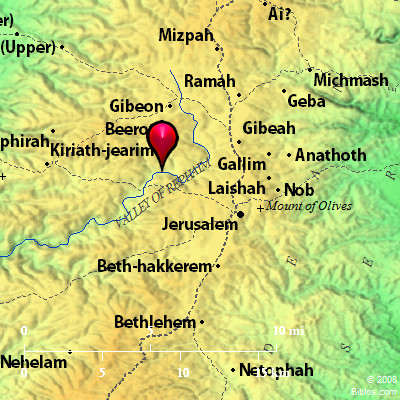Atlas  Valley of Rephaim and surrounding area Maps Created using Biblemapper 3.0 Additional data from OpenBible.info You are free to use up to 50 Biblos coprighted maps (small or large) for your website or presentation. Please credit Biblos.com. Occurrences Joshua 15:8 The border went up by the valley of the son of Hinnom to the side of the Jebusite southward (the same is Jerusalem); and the border went up to the top of the mountain that lies before the valley of Hinnom westward, which is at the farthest part of the valley of Rephaim northward.Joshua 18:16 The border went down to the farthest part of the mountain that lies before the valley of the son of Hinnom, which is in the valley of Rephaim northward. It went down to the valley of Hinnom, to the side of the Jebusite southward, and went down to En Rogel. 2 Samuel 5:18 Now the Philistines had come and spread themselves in the valley of Rephaim. 2 Samuel 5:22 The Philistines came up yet again, and spread themselves in the valley of Rephaim. 2 Samuel 23:13 Three of the thirty chief men went down, and came to David in the harvest time to the cave of Adullam; and the troop of the Philistines was encamped in the valley of Rephaim. 1 Chronicles 11:15 Three of the thirty chief men went down to the rock to David, into the cave of Adullam; and the army of the Philistines were encamped in the valley of Rephaim. 1 Chronicles 14:9 Now the Philistines had come and made a raid in the valley of Rephaim. Isaiah 17:5 It will be like when the harvester gathers the wheat, and his arm reaps the grain. Yes, it will be like when one gleans grain in the valley of Rephaim. Encyclopedia REPHAIM, VALE OF(`emeq repha'-im; koilas Rhaphaeim, koilas ton Titanon): This was a fertile vale (Isaiah 17:5), to the Southwest of Jerusalem (Joshua 15:8; Joshua 18:16; the King James Version "Valley of the Giants"), on the border between Judah and Benjamin. Here David repeatedly defeated the invading Philistines (2 Samuel 5:18, 22; 2 Samuel 23:13 1 Chronicles 11:15; 1 Chronicles 14:9). It is located by Josephus between Jerusalem and Bethlehem (Ant., VII, iv, i; xii, 4). It corresponds to the modern el-Biqa`, which falls away to the Southwest from the lip of the valley of Hinnom. The name in ancient times may perhaps have covered a larger area, including practically all the land between Jerusalem and Bethlehem, where the head-waters of Nahr Ruben are collected. |



